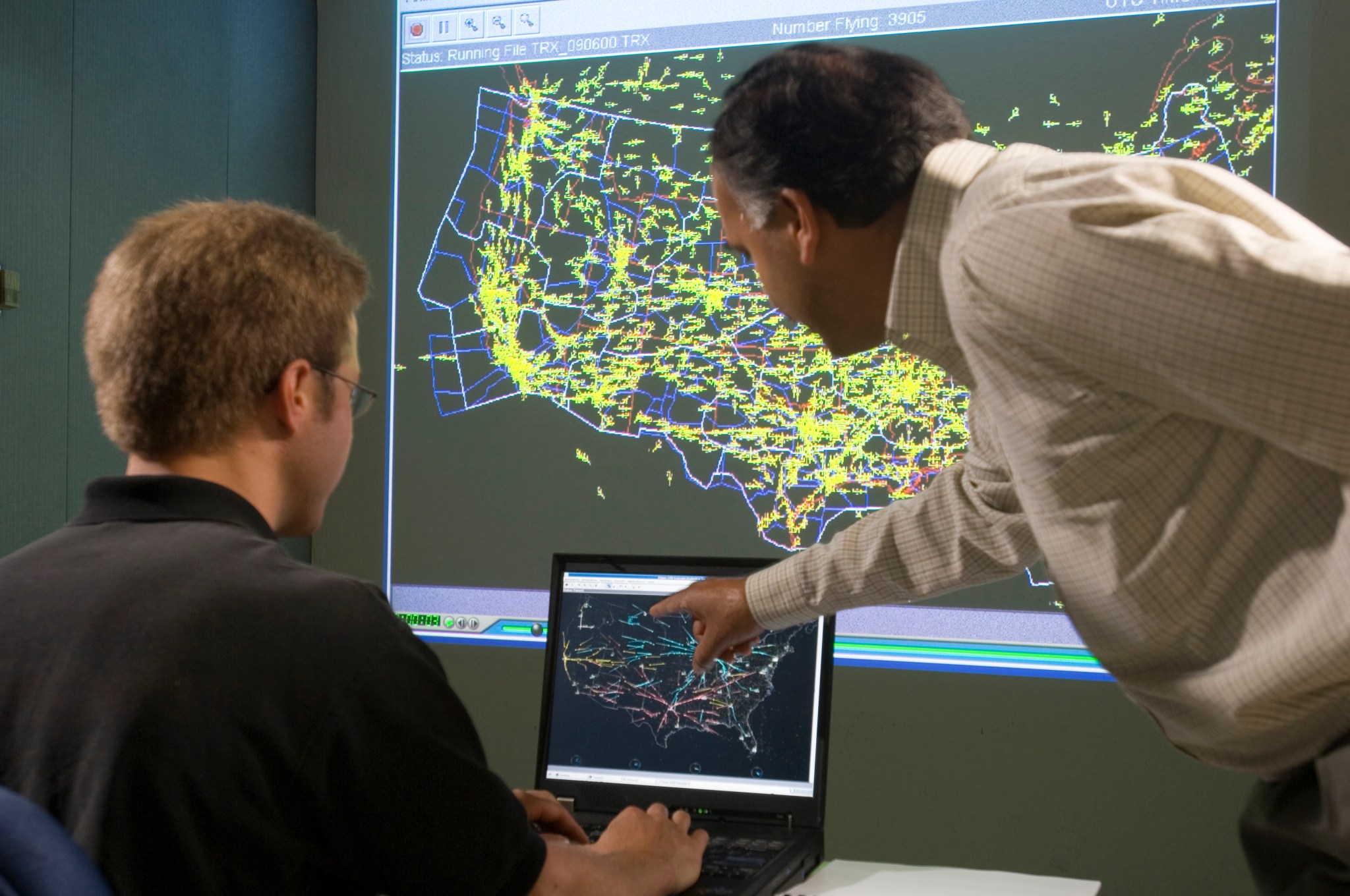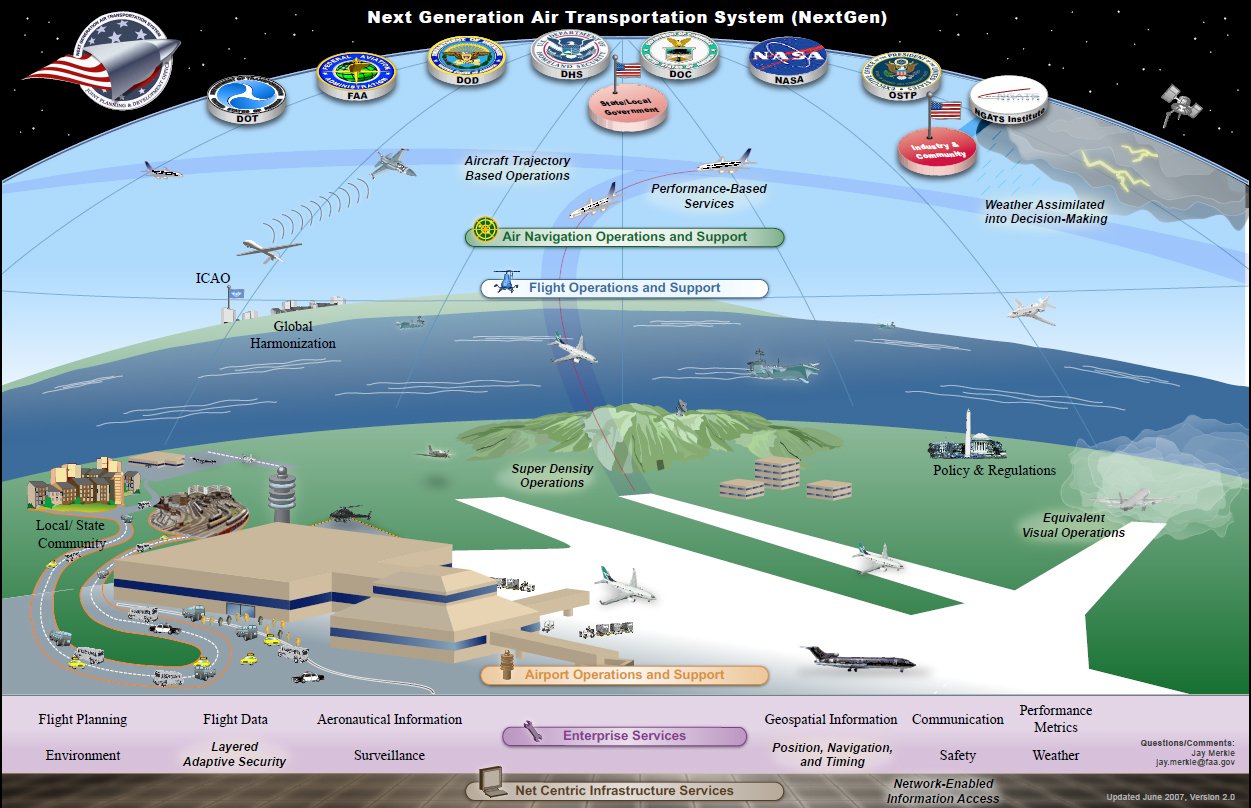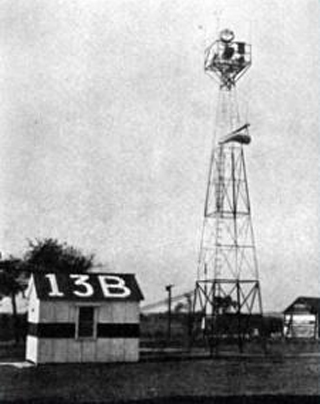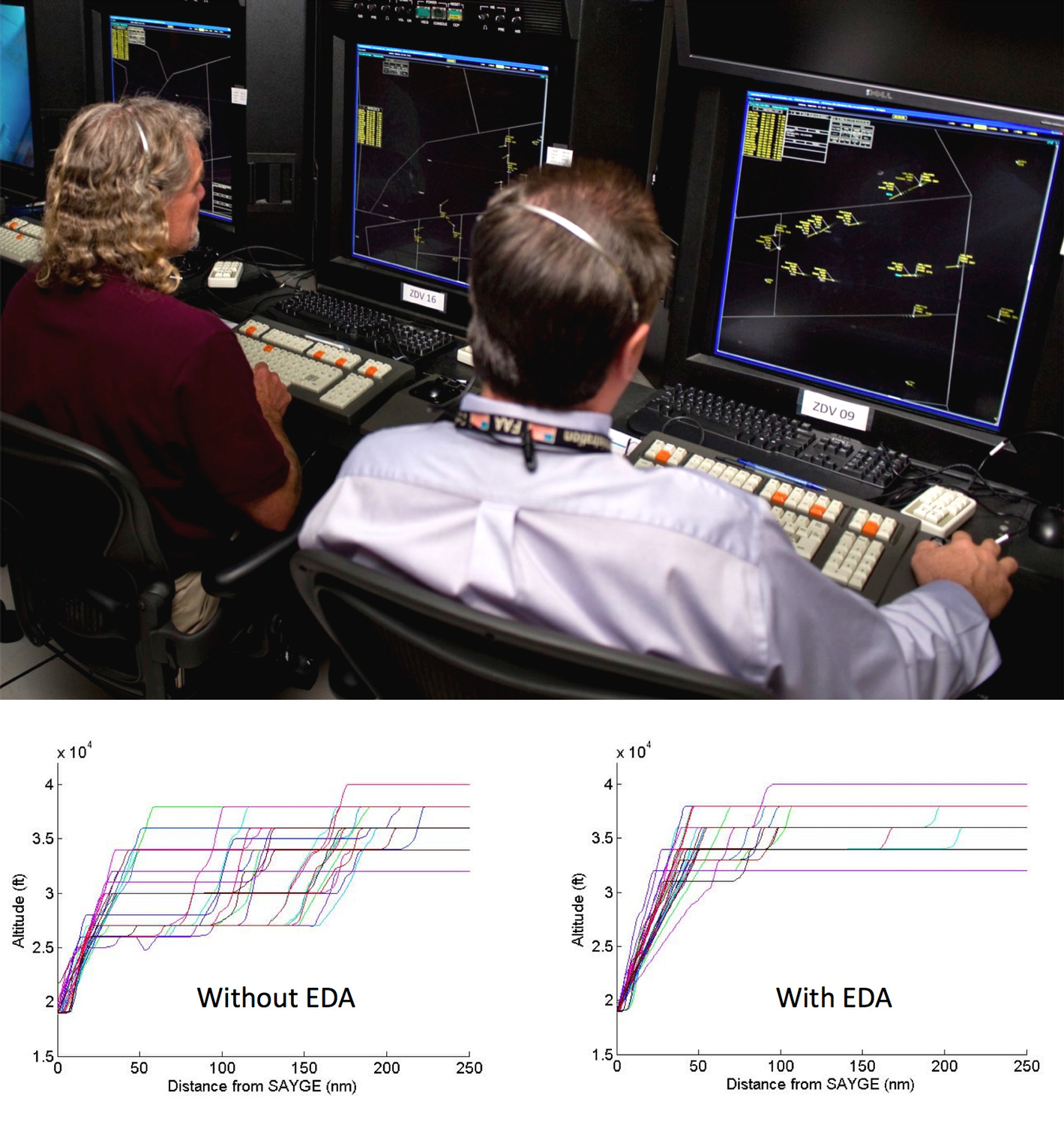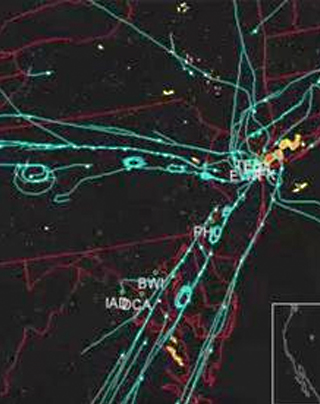The United States is undertaking the largest transformation of air traffic control ever attempted. Known as the Next Generation Air Transportation System, or NextGen, it is a multi-billion-dollar technology modernization effort that will make air travel safer, more flexible and more efficient. As the system gets better, its capacity will grow and the demand for different types of air transportation – even unmanned aircraft – will increase.
NASA is one of several U.S. government agencies that play a crucial role in helping to plan, develop and implement NextGen. NASA’s role is research and development of new ideas and technologies that will make NextGen a reality. We’re working on software that reduces airport runway and surface congestion, new landing techniques that save fuel and time, computer models that predict more accurately the influence of weather on flight paths, and air traffic control solutions that allow more takeoffs and landings in the same amount of time.
Because NextGen is not just about air traffic management, we’re also working on the tools and scientific knowledge needed to advance engine and airframe technology for today’s aircraft, and develop unconventional new vehicles that will fly faster, cleaner and quieter, and use less fuel.
We asked NASA researchers to answer some questions about NextGen and the aircraft that will make the system complete.
Below, Leighton Quon, project manager of NextGen Systems Analysis, Integration, and Evaluation at NASA’s Ames Research Center, Moffett Field, Calif., answers eight questions about what NASA is doing to help improve air transportation for all of us in the future.
Coming soon: A question-and-answer session with the managers of projects working to develop advanced design ideas for the new and improved aircraft that will be flying in NextGen.
1) What is “NextGen”?
Leighton: NextGen stands for the Next Generation Air Transportation System. The current air transportation system includes all of the air traffic controllers, their equipment and software, the control tower facilities in which they work, the radars and the radio beacons on the ground that help pilots navigate throughout the country. Basically, it’s what gets aircraft on their planned paths and what keeps them from flying too close to each other. The Federal Aviation Administration (FAA) leads the process of implementing updates to that system, with NASA and others as partners. We call the updates “NextGen.”
2) What would be the benefits of an updated air transportation system?
Leighton: NextGen will make air travel more dependable and efficient. In this case, “efficient” means to reduce the resources with less fuel burned, less time taken or even more flights in a given time. It will provide improvements to how air traffic is managed, saving fuel and reducing noise, emissions, congestion and delays.
3) How will NextGen affect me?
Leighton: It will allow more planes in the sky, which means more air travel options. It will allow more efficient routes that will get you where you’re going faster with fewer delays. And , it will do it all with fewer emissions. If you live near an airport, NextGen will also help reduce noise near your home. The system will be less prone to major disruptions such as storms, too.
4) Why NextGen now?
Leighton: Air traffic management has evolved over time, but it hasn’t changed very much since the 1950s. For example, in the early 1920s the U.S. Postal Service had the mail flown across the country mostly during daylight hours. A way to fly the mail at night was needed, so they would place bonfires along the navigational routes and the planes would fly from bonfire to bonfire. The planes weren’t that fast and there weren’t as many aircraft flying, so a method of visual guidance was enough to get everyone where they needed to go. The bonfires were replaced with radio beacons in the 1930s. In the 1950s, radar was introduced. Ever since then, the air traffic management system has relied on post-World War II era technologies of radio-based navigation aids, radar and radios. Today we are using advanced versions of these same technologies.
5) How will NextGen be different?
Leighton: Aircraft generally fly indirect, even zig-zag, paths over a series of ground-based radio beacons. Controllers “watch” the progress of the flights on radar and direct the aircraft individually by radio if they need to alter their paths. The efficiency of a flight route is very limited by the old radio, ground based beacons and radar technology. NextGen will use modern technologies to determine the position of planes much more precisely so they don’t need to follow the ground stations. A satellite-based positioning system using GPS called Automatic Dependent Surveillance-Broadcast, or ADS-B, will be used to accurately determine the position of an aircraft, and this accurate information will be broadcast over a network. Computers, both in the aircraft and on the ground, will help offload some of the work and information processing from humans to support choosing the most efficient paths to fly while still keeping a safe distance from other aircraft. All of these technologies working together will help make air travel more dependable and efficient.
6) What is NASA’s role in NextGen?
Leighton: The primary role of NASA in the NextGen partnership is research and development of concepts and technologies. In the Airspace Systems Program where I work at NASA, we divide this into two groups – one that develops new concepts and technologies, and the other – the area I manage – analyzes, integrates and evaluates the new ideas to get them closer to being ready to use. We’re all working toward new and innovative ways to manage air traffic, primarily through creating new software tools and new ways of doing things, in the air and on the ground. We have years of successful work on all kinds of aspects of this, but the ground-based technologies that allow controllers in all of their various roles to be more efficient and handle more aircraft traffic is one of our big areas of focus. This includes new computer applications, computer systems, hardware and ways to use all of these together in an integrated way. So NASA develops new ideas, tries them out through simulations and field tests, and reports the results to the FAA. The FAA then uses that background to create new formal air traffic management procedures, tests those out to make sure they’re safe, certifies them and makes them operational.
7) Specifically, what kinds of things are researchers working on right now?
Leighton: There are a bunch of things researchers are working on. We try and address the major constraints that create inefficiencies, and this generally includes all the phases of flight from your departure gate to your arrival gate, as well as other issues that might relate to weather. From the time you board your flight and are ready to leave the gate, there are already opportunities to make the operations more efficient with new concepts we are developing. Here are some examples:
- Precision Departure Release Capability
Sometimes you hear that there is weather or congestion delaying your flight. When this situation occurs, the FAA may start their “Call For Release” (CFR) program. Imagine trying to get into the busiest restaurant in town. You definitely will want a reservation and once you have your reservation you want to make sure you don’t miss it, right? The Precision Departure Release Capability (PDRC) is reducing the chances of missing your reservation (we call them “slots”) by determining when is the ideal time to have your flight begin its journey so that it doesn’t miss its slot in all the air traffic. Last January alone, there were about 8,700 missed slots, which translates into hours and hours of cumulative waiting to get into a new slot, which means late flights and delays. - Spot and Runway Departure Advisor
To help the flight move from the departure gate to the runway without numerous stops and starts, then more waiting in line for the runway (both of which are very inefficient for fuel use and emissions), the Spot and Runway Departure Advisor (SARDA) will help plan which planes should head for the runway, when and what route to use so that everybody gets to leave at the correct time – and as fast as possible.
- Trajectory Based Automation System
While your flight is airborne at cruise altitude, the Trajectory Based Automation System (TBAS) will help find the most direct route to fly, saving time and fuel by avoiding all those zig-zags. Even if there’s bad weather along the route you want to fly, TBAS will automatically look for the best route available around the weather. - Efficient Descent Advisor and 3-Dimensional Path Arrival Management
As you get closer to your destination the Efficient Descent Advisor (EDA) tool will use 3-Dimensional Path Arrival Management (3DPAM) concepts to determine the best time and place to begin your descent so that the plane can make a smooth gliding descent with the engines idling all the way down, saving fuel and making less noise as planes fly over neighborhoods. Imagine being in your car, cruising down your street on your way home and being able to take your foot off the gas at the perfect time to roll to a stop in your driveway without having to use the gas and brake – smooth, efficient and quiet.This video shows actual aircraft movement around the terminals at a commercial airport. The terminals are the area of activity in the center. Each of seven grey lines represents a runway and the pink, cyan and yellow dots represent aircraft. To get to and from the terminals, aircraft are often waiting to cross runways. As they idle, passengers are waiting and the engines are burning fuel. Video credit: NASA Ames Research Center -
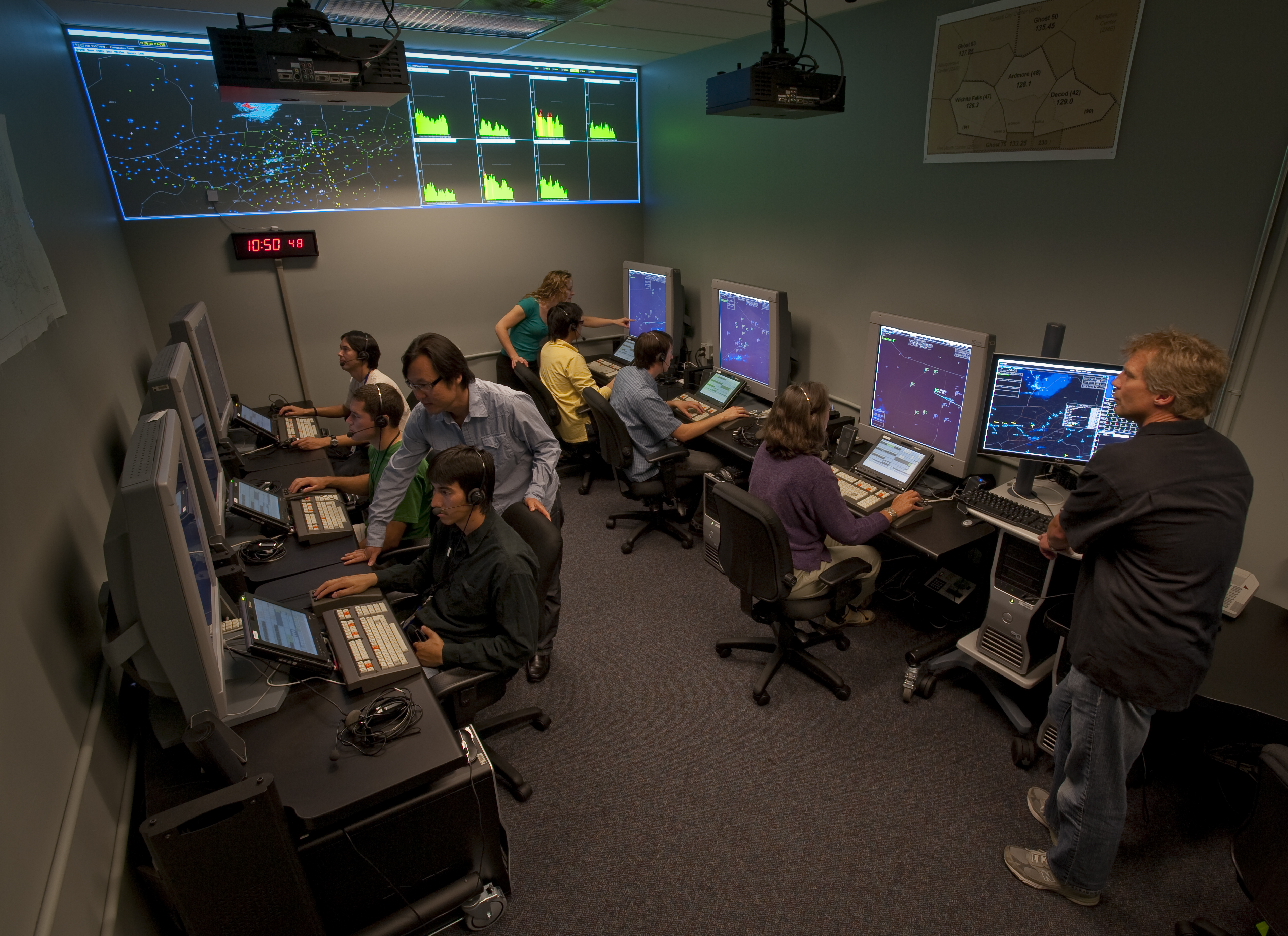
Shon Grabbe and Kapil Sheth discuss the traffic situation in the continental U.S. with the help of Future Air Traffic Management (ATM) Concepts Evaluation Tool (FACET). NASA is using these technologies to begin to understand the processes that affect the national airspace system. Air Traffic Management (ATM) Technology Demonstration
One of the challenges once you start your descent is the congestion of all the arriving airplanes for the same airport. They all have to once again get merged into an organized order and slow down for the final approach and landing. This “compresses” the traffic into a tight bunch of aircraft trying to land. The first Air Traffic Management (ATM) Technology Demonstration (ATD-1) will demonstrate the ability to make the best arrival schedule to accommodate everyone. (Yes, sometimes we nest acronyms into acronyms – more confusing to look at, but faster to say and type once you know what they mean!). Three NASA-developed technologies will be integrated into ATD-1:- Advanced scheduling based on more accurate position information from aircraft, using ADS-B, will make the best arrival schedule to accommodate everyone.
- Controller tools will be integrated with the scheduling tools to help keep aircraft spaced properly and on schedule.
- Advanced cockpit instrumentation and information will allow the pilots to maintain their proper position and safe spacing in the arrival stream of aircraft without occupying unneeded space.
- Together, these tools will bring your flight to the runway landing on schedule and SARDA will once again help find the best path for your plane to make its way into its arrival gate.
Even some of these new technologies could use additional information from time to time. When the winds at an airport begin to change, the runways used for takeoff and landing may have to be switched. For example, all the airplanes may have to start landing from the north when they were landing from the east. The Runway Configuration Manager (RCM) is a tool that will give information to either the operators or potentially some of the other automated scheduling tools when the airport setup needs to be changed. With enough advance notice, the airplanes can be directed to the new runways without wasting time and fuel turning around on the airport taxiways or changing directions in the air.
Additionally, there are various weather issues that could happen in one small area that can affect the airline operations throughout the country. In San Francisco, stratus is the marine layer or “fog” that the Bay Area sees during the summer months. Because the layer can obscure the pilot’s view of the airport during landing, the aircraft must fly an instrument-guided approach. Currently, when there’s fog like this, planes have to land single-file into the San Francisco airport (SFO), as opposed to when it is clear and planes can approach and land in pairs, almost side by side. NASA has developed a computer tool we call SFO Stratus that helps advise the FAA System Command Center, where the nation’s “coaches calling the plays” for the whole national system are located. With the tool advisories, they can make more accurate decisions on when to let airplanes around the country leave for San Francisco so that by the time the planes arrive the fog will have lifted and they can use the more efficient side-by-side arrivals. Without the tool, the FAA System Command Center may send too many planes too early or perhaps might hold planes back all over the country, unnecessarily causing delays to you and me during our travels.
8) When will all this affect me?
Leighton: Technologies such as the SFO Stratus tool were actually being tested in the field by the FAA in the 2011 summer season. During this test phase there should be some benefit for the whole system including travelers. Each of the other technologies is in various stages of development. The PDRC is about to make its way into field testing for the first time. EDA, TBAS, SARDA and the components of ATD-1 have seen extensive testing in NASA’s own simulation labs. This is typically the step right before trying them in the real world. There are numerous other technologies in early stages of development and experiments by researchers, not to mention the ideas yet to be thought of by our innovative staff.
Permanent implementation of the tools will be the responsibility of our partner agency, the FAA. It operates air transportation every day of the year so that we can fly to the multitude of places we want to or need to go, and will build and implement the actual Next Generation system of the future.
› Read 8 Questions About NextGen, Part 2




























